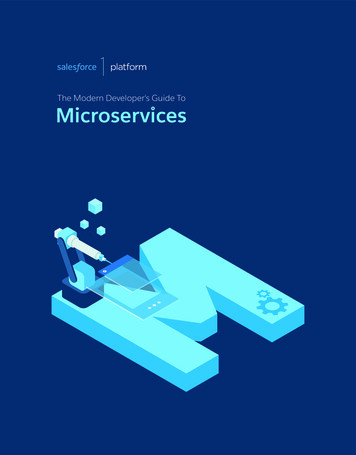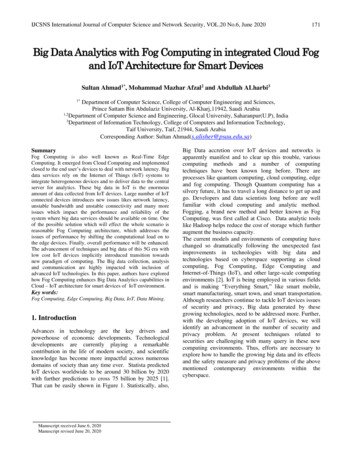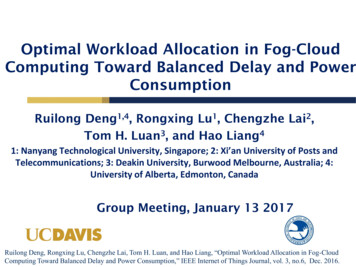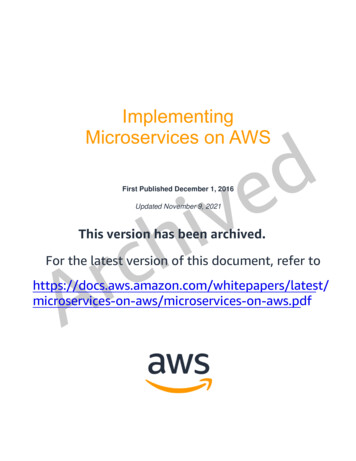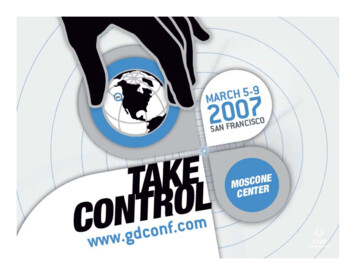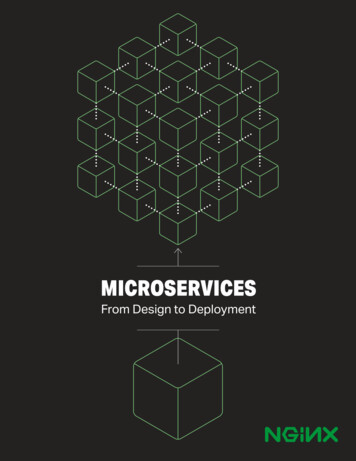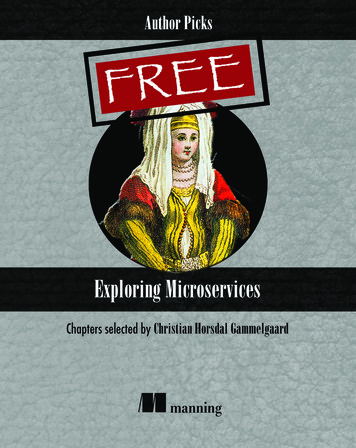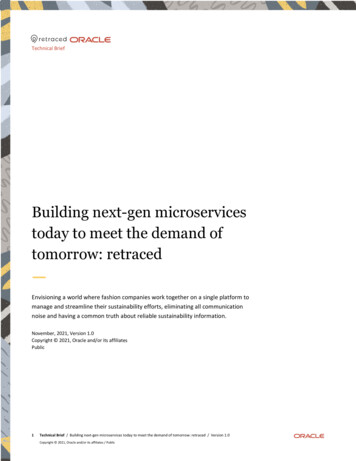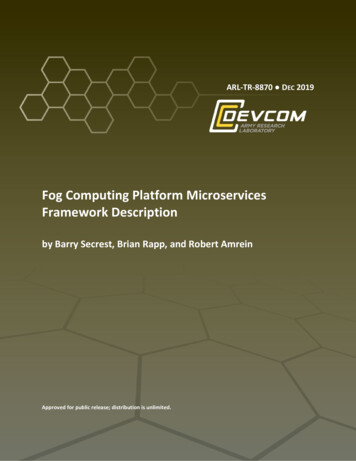
Transcription
ARL-TR-8870 DEC 2019Fog Computing Platform MicroservicesFramework Descriptionby Barry Secrest, Brian Rapp, and Robert AmreinApproved for public release; distribution is unlimited.
NOTICESDisclaimersThe findings in this report are not to be construed as an official Department of theArmy position unless so designated by other authorized documents.Citation of manufacturer’s or trade names does not constitute an officialendorsement or approval of the use thereof.Destroy this report when it is no longer needed. Do not return it to the originator.
ARL-TR-8870 DEC 2019Fog Computing Platform Microservices FrameworkBarry Secrest and Brian RappComputational and Information Sciences Directorate,CCDC Army Research LaboratoryRobert AmreinTechnica CorporationApproved for public release; distribution is unlimited.
Form ApprovedOMB No. 0704-0188REPORT DOCUMENTATION PAGEPublic reporting burden for this collection of information is estimated to average 1 hour per response, including the time for reviewing instructions, searching existing data sources, gathering and maintaining thedata needed, and completing and reviewing the collection information. Send comments regarding this burden estimate or any other aspect of this collection of information, including suggestions for reducing theburden, to Department of Defense, Washington Headquarters Services, Directorate for Information Operations and Reports (0704-0188), 1215 Jefferson Davis Highway, Suite 1204, Arlington, VA 22202-4302.Respondents should be aware that notwithstanding any other provision of law, no person shall be subject to any penalty for failing to comply with a collection of information if it does not display a currentlyvalid OMB control number.PLEASE DO NOT RETURN YOUR FORM TO THE ABOVE ADDRESS.1. REPORT DATE (DD-MM-YYYY)2. REPORT TYPE3. DATES COVERED (From - To)December 2019Technical ReportOctober 2018–September 20194. TITLE AND SUBTITLE5a. CONTRACT NUMBERFog Computing Platform Microservices Framework5b. GRANT NUMBER5c. PROGRAM ELEMENT NUMBER6. AUTHOR(S)5d. PROJECT NUMBERBarry Secrest, Brian Rapp, and Robert Amrein5e. TASK NUMBER5f. WORK UNIT NUMBER7. PERFORMING ORGANIZATION NAME(S) AND ADDRESS(ES)8. PERFORMING ORGANIZATION REPORT NUMBERCCDC Army Research LaboratoryATTN: FCDD-RLC-NCAberdeen Proving Ground, MD 21005ARL-TR-88709. SPONSORING/MONITORING AGENCY NAME(S) AND ADDRESS(ES)10. SPONSOR/MONITOR'S ACRONYM(S)11. SPONSOR/MONITOR'S REPORT NUMBER(S)12. DISTRIBUTION/AVAILABILITY STATEMENTApproved for public release; distribution is unlimited.13. SUPPLEMENTARY NOTES14. ABSTRACTThe Internet of Things relies on centralized Cloud computing and highly reliable networking. When applied to the battlefield,the anticipated benefits to the warrior include increased battlefield awareness and Anticipatory Analytics that exploit theexplosion of available data. The battlefield environment, however, is contested by the adversary through electronic and cyberwarfare and does not support a highly reliable network or Cloud computing. Through Fog Computing we are able to work in acontested network and provide the benefits of Cloud computing without a Cloud, using devices that are much lower SWaP(size, weight, and power) than traditional architectures required for big data, artificial intelligence, and other computationheavy tasks. Fog Computing combines all battlefield compute resources to form a robust, resilient, distributed computationalcapability providing Cloud benefits closer to the edge. This report documents the framework for microservices in FogComputing.15. SUBJECT TERMSdistributed computing, Cloud services, edge computing, Fog Computing, computer architecture16. SECURITY CLASSIFICATION OF:a. REPORTUnclassifiedb. ABSTRACTUnclassifiedc. THIS PAGEUnclassified17. LIMITATIONOFABSTRACT18. NUMBEROFPAGESUU20ii19a. NAME OF RESPONSIBLE PERSONBarry Secrest19b. TELEPHONE NUMBER (Include area code)410-306-1313Standard Form 298 (Rev. 8/98)Prescribed by ANSI Std. Z39.18
ContentsList of FiguresivList of Tablesiv1.Introduction12.FCP Background12.1 Fog Computing12.2 FCP Implementation and Overall Architecture22.3 Microservices33.Implementation Details44.Sample Client64.1 example client.py64.2 example config.ini95.Case Study96.Future107.Conclusion118.References12List of Symbols, Abbreviations, and Acronyms13Distribution List14iii
List of FiguresFig. 1FCP architecture. 2List of TablesTable 1Speech-to-Text microservice development phases . 10iv
1.IntroductionFog Computing Platform Microservices Framework (FCP-MF) is a high-levelapplication programming interface (API) that allows developers to easily andquickly build Fog Computing Platform (FCP)-compatible microservices. It allowsthe developers to concentrate on the microservice functionality and not worry aboutlower-level details like sending and receiving messages to process, configure,encrypt, and log formatting that are essential for a well-running microservice butdistract from the core implementation of the microservice.Currently, the FCP-MF is developed as an abstract Python implementation forPython-based microservices but this can be expanded to other languages such asJava and C/C .2.FCP BackgroundFCP is designed to process Internet of Things (IoT) events in near real-time. Fognodes are deployed close to the data sources to offload some of the analytics burdenfrom the cloud. Faster results are obtained, and with less security risk, thantransmitting all data to central servers for processing.An intuitive web-based user interface provides a full suite of services foradministrators to configure a microservice, deploy it to a fog node, monitor itsstatus, start and stop the microservice, and send an updated configuration to arunning microservice. These functions are initiated on individual nodes or onclusters of nodes.The FCP architecture is powered by microservices: discrete software componentsdeployed at the fog and edge layers to perform specific functions. They includesupport services such as databases and message brokers; also, analytic services suchas neural networks and machine-learning algorithms.2.1 Fog ComputingDue to increasing demands/deployments of IoT, the Fog Computing construct hasgained considerable ground. In March 2018, National Institute of Standards andTechnology (NIST) released Special Publication 500-325, the NIST FogComputing Conceptual Model.1 NIST describes Fog Computing as a mechanism todecentralize applications, management, and data analytics into the network itselfusing a distributed and federated compute model. Fog Computing can be contrastedwith cloud computing in that, while the cloud is high in the air with pristine networkconnectivity and unlimited compute, the fog is closer to the ground—where IoT1
sensors/devices live. Fog networks generally have intermittent and limitedconnectivity and also have reduced compute available. Fog Computing is especiallyrelevant for tactical environments because compute, analytics, storage, and so oncan be brought closer to edge devices/sensors operating in networks facing DeniedDisconnected Intermittent Limited bandwidth challenges.It is important to note the Fog Layer is abstract. There is no one-size-fits-all model.Different use cases will require different configurations of Fog Nodes. Fog Nodescan be organized hierarchically, such that a lower-level node sends acondensed/subset stream of data to a higher-level node. For example, a Soldier’sFog Node could only communicate with the higher-level Fog Node on the Humvee.Or, the Soldier may not have a Fog Node at all—his/her sensors may talk directlyto the Humvee’s Fog Node. Additionally, it may be the case that the Soldier’s FogNode (due to reduced power, space, processing, etc.) may not be considered atactical high-performance computing (HPC) device, while the Humvee Fog Nodewould be a tactical HPC device.2.2 FCP Implementation and Overall ArchitectureFigure 1 depicts FCP notional architecture and the publishing and subscriptiontasks that occur between the microservices and the broker.Fig. 1FCP architectureThere are two types of end users shown in the diagram. The end user on the leftrepresents users of a client application that makes use of the data coming from theedge and fog. The application listens for the data, processes them in some way, and2
formats the data for users to see. The end user on the right side is a SmartFogadministrator, who deploys and manages the microservices from the cloud.Message Queue Telemetry Transport (MQTT) is the message-broker technologythat enables the microservices to communicate with each other and between theedge and cloud layers. However, similar brokers, such as Advanced MessageQueuing Protocol, can be used as well. While each device does not need its ownMQTT broker, it must have access to a broker; therefore, each FCP deploymentmust include at least one message-broker server.2.3 MicroservicesMicroservice Architecture (MSA) is a specific type of software development thatconcentrates on building single-purpose modules with well-defined interfaces andoperations. The MSA paradigm has grown in popularity in recent years as theenterprise seeks to become more agile and move toward a continuousintegration/testing pattern found in DevOps solutions. Additionally, manyopen-source projects such as Docker, Singularity, and SaltStack have facilitatedMSA adoption. MSA can help create scalable, testable software that can bedelivered daily/weekly.MSA structures an application as a set of services based on business functionality.In general, microservices have the following features: Highly maintainable and testable Loosely coupled Independently deployable Organized around business capabilitiesIn addition, FCP microservices are easily configured, deployed, and maintained by an administrator, process input and output through a message broker, are containerized, continue operating while being disconnected from the cloud, allow resiliency with slow or unstable network connections, accept dynamic configuration updates, either manually from administratorsor dynamically from higher-level systems, and3
communicate with each other over TLS-encrypted connections.FCP-MF provides structureFCP-compatible Implementation DetailsThe FCP-MF packages provide an abstract implementation of core microservicefunctionality to use when implementing microservices for the FCP. Microservicesconsist of a data MQTT client, an optional configuration MQTT client, dataserializers and other various administrative functions that enables a unifiedinterface for creation, logging and configuration of new microservices operatingover the MQTT protocol.The fogms package is for MQTT-based microservices that will retrieve their datafrom MQTT, do some processing on the data, and send their output messages toMQTT.The fogms package provides the following five features to clients.1) Defines a standard MQTT configuration object:This object details all parameters needed to create a secure connection to anMQTT broker. Developers can then ensure that these parameters are presentin the microservice configuration. The configuration object also validatesthe parameters to safeguard against invalid values being passed into themicroservice.2) Connects to MQTT brokers and automatically registers on messagecallback for received messages:After calling connect clients() the connection to the MQTT broker will beestablished, and all topics defined in the MQTTConfiguration object will besubscribed to and linked to the on message() method of the implementingobject. A shutdown class is also provided to cleanly disconnect frombrokers when the microservice is being terminated.3) Registers the update callbacks if defined:Microservices can support dynamic configuration changes. They do this bylistening on a specified update topic. This can be a separate MQTT brokerthat the microservice connects to for normal data processing. Theframework facilitates managing this separate broker configuration,subscribing to the update topic, handling the new configuration, andmanaging reloading for the new configuration to take effect.4
4) Standardizes log messages:Microservices use the standard Python logging mechanism but theframework standardizes the format of the log messages so they areconsistent across microservices.5) Provides a pluggable serializer for incoming and outgoing messages:Messages coming into and out of a microservice can be in a variety offormats. The pluggable serializer functionality allows clients to create ahandler to convert to and from external data formats and the internal datastructures required in the microservice. There is JavaScript Object Notation(JSON) Serializer available for use, but developers can write their own aswell.When inheriting the microservice, abstract base class developers must do thefollowing:1) Call super() init in the class initialization passing the parametersa. data mqtt config (MQTTConnectionConfig): configuration objectfor the data MQTT clientb. update mqtt config (MQTTConnectionConfig, OPTIONAL):configuration object for the MQTT client to receive real-time configupdatesc. serializer (fogms.payload serializers, OPTIONAL): serializerobject used to conveniently serialize/deserialize payloadsd. logger name (str, OPTIONAL): name of logger level2) Implement abstract methodsa. on message(): define default callback for topic subscriptionsb. validate(): e3) Call connect clients() to make the connection to the MQTT broker andsubscribe to topics for incoming messages.These interfaces are written as a Python module, which makes it very easy to usein developing new microservice code by simply importing the appropriate modulecomponents.5
4.Sample ClientThe following passage is a simple Fog Microservice that shows how the FCP-MFshould be used. This is a very simple service that connects to an MQTT broker,receives a message, and outputs a message on the configured topics. Section 4.1shows the microservice code implemented in Python, and Section 4.2 shows theconfiguration file for the service.4.1 example client.pyfrom fogms import configurationsfrom fogms.microservice import microservicefrom fogms.func. general func import logging formatfrom fogms.payload serializers.JSONSerializer import JSONSerializerfrom datetime import datetimeimport loggingimport argparseimport configparserimport sysimport timeimport jsonclass SimpleService(microservice):'''Put any initialization code for the service in this method'''def init (self, data mqtt config, update mqtt config, serializer):super(). init (data mqtt config data mqtt config,update mqtt config update mqtt config,serializer serializer)'''Used to validate the configuration if necessary'''def validate(self):#validate method - way to validate data members by type/valueself.logger.debug("Validating.")6
'''Called when a message is received on the MQTT topic defined in theconfiguration'''def on message(self, client, userdata, msg):self.logger.info("Received message for processing from MQTT")self.logger.info("\tOn Topic: %s", msg.topic)self.logger.info("\tMsg: %s", msg.payload)#Service isn't really doing anything.But this is where the#interesting pieces would go.#Do something interesting with the incoming message then create the outputself.logger.info("Doing some important work here.")raw msg { "msg": "Hello World","success": "True" }json msg self.serializer.serialize(raw msg, "data")#Send result to MQTTself.dataClient.publish msg(json msg)self.logger.info("Successfully sent results to MQTT")def main():logger logging.getLogger( name )#Read the config file location from the command linecl argparse.ArgumentParser()cl.add argument('--config path', '-c', type str,default './exmple client.ini',help 'Full path to config file')cl.add argument('--log path', type str, default './',help 'Path to write log files')cl args cl.parse args()log file name datetime.now().strftime('example ms %d %m %Y')logging.basicConfig(format logging format(), level logging.DEBUG,handlers [7
logging.FileHandler("{0}/{1}.log".format(cl args.log path, log file name)),logging.StreamHandler()])#get the config file and parselogger.info("Parsing config from {}".format(cl args.config path))config configparser.ConfigParser()with open(cl args.config path) as data file:config.read file(data file)config errors False#load MQTT configuration items from file into MQTT Configuration Objecttry:mqtt dict {}mqtt dict['host'] config['mqtt']['host']mqtt dict['port'] config.getint('mqtt','port')mqtt dict['pub topic'] config['mqtt']['pub topic']mqtt dict['sub topics'] config.get('mqtt','sub topics').split(',')mqtt dict['ssl protocol'] config['mqtt']['ssl protocol']mqtt dict['keepalive'] config.getint('mqtt','keepalive')mqtt dict['sub qos'] config.getint('mqtt','sub qos')mqtt dict['pub qos'] config.getint('mqtt','pub qos')mqtt dict['mqtt protocol'] config.getint('mqtt','mqtt protocol')mqtt dict['ssl cert path'] config['mqtt']['ssl cert path']mqtt c configurations.MQTTConnectionConfig(c mqtt dict)mqtt c.output config()except AssertionError:config errors True#Instantiate and initialize the service classjsonSerializer JSONSerializer()simpleMS SimpleService(data mqtt config mqtt c,update mqtt config None,serializer jsonSerializer)#Connect to MQTT and start listening for messages8
simpleMS.connect clients()try:while it(1)if name ' main ':main()4.2 example config.ini[mqtt]host x.x.x.xport 8883pub topic example/outsub topics example/inssl protocol tls 12keepalive 180sub qos 2pub qos 2mqtt protocol 311ssl cert path ./certs/ca-chain.crt5.Case StudyTo get an idea of efficiency speed-up of using the FCP-MF in creating newmicroservices, this section will review the Speech-to-Text application that wasrecently converted to an FCP microservice. This was part of a larger effort toconvert a speech-to-speech translation application and run it in the FCP, but willfocus just on the speech-to-text portion of the workflow.This developmental effort was done without the aid of the FCP-MF. Table 1 detailsthe microservice-development process with the high-level tasks and associatedeffort involved.9
Table 1Speech-to-Text microservice development phasesTaskEffortResearch72 hDesign24 hDevelopment48 hTesting48 hMost of the time used in converting this functionality to a microservice was forlearning and understanding the speech-to-text algorithms. For this effort we usedKaldi, which is a speech-recognition toolkit that uses machine learning. This had alarge learning curve that accounted for most of the time used in the research phase.However, we estimate the use of the FCP-MF would cut the development andtesting time by 25%–50%. By using this toolkit, the developer no longer must worryabout many of the details required to connect to and process messages from theFCP. Also, this cuts down testing time by reusing code that has already beenthoroughly tested and used in other microservices.6.FutureThe FCP-MF has enormous potential for growth. Possibilities to increase itsusefulness include the following: Expanded set of common APIsAs the microservice catalog expands, additional common services could beextracted into the Microservices Framework (MF) and made available to allmicroservices. For example, microservice developers would find these APIshelpful:o Health Check Endpointo Telemetry and Metricso Automated Test Integration Additional language supportCurrently, the MF extensions are written in Python. However,microservices can be written in any language. As more microservices aredeveloped in other languages, the creation of similar abstract10
implementations in languages such as Java and C/C is a naturalevolution. Other common functionalityAdditional modules can be created to handle other common tasks inmicroservices. One that might be especially useful would be support formachine-learning toolkits to do inference quickly and easily in amicroservice.7.ConclusionThe FCP-MF comprises APIs that allow microservice developers to focus on thebusiness functionality of the microservice and not be concerned about commontasks like securely connecting to message brokers and receiving and processingmessages.The FCP-MF today provides a strong base set of functionality for microservicedevelopers, but the expanded support of common APIs, languages, and machinelearning envisioned for subsequent revisions would increase the usefulness andtime savings for developers in the future.11
8.1.ReferencesIorga M, Felman L, Barton R, Martin MJ, Goren N, Mahmoudi C. Fogcomputing conceptual model. Gaithersburg (MD): National Institute ofStandards and Technology; 2018 Mar. NIST Special Publication No.: 500-325.12
List of Symbols, Abbreviations, and AcronymsAPIapplication programming interfaceFCPFog Computing PlatformFCP-MFFog Computing Platform-Microservices FrameworkHPChigh-performance computingIoTInternet of ThingsJSONJavaScript Object NotationMFMicroservices FrameworkMQTTMessage Queue Telemetry TransportMSAMicroservice ArchitectureNISTNational Institute of Standards and TechnologyTLSTransport Layer Security13
1DEFENSE TECHNICAL(PDF) INFORMATION CTRDTIC OCA1CCDC ARL(PDF) FCDD RLD CLTECH LIB2CCDC ARL(PDF) FCDD RLC NCB RAPPB SECREST14
Microservices use the standard Python logging mechanism but the framework standardizes the format of the log messages so they are consistent across microservices. 5) Provides a pluggable serializer for incoming and outgoing messages: Messages coming into
